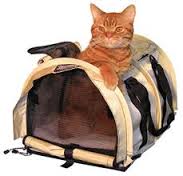Stress-free Moving for Your Best Friend
Moving into a new home is probably one of the more common yet stressful life events you will go through. And because pets have an instinctive fear of new surroundings, pet owners will want to help them adjust quickly and easily. With all of the planning, packing, organizing, donating and scheduling involved you may not even have time to consider how stressed your pets feel also. ![images[8]](https://keymoving.com/wp-content/uploads/2015/03/images8.jpg) There are new sounds and smells everywhere…tape tearing, boxes stacking, furniture being moved around, new people everywhere, truck engines…lots of moving parts that can easily become overwhelming for your unassuming pet. According to the ASPCA Director of Anti-Cruelty Behavior Research, Dr. Katherine Miller, there specific ways to make the transition safe and easy for your four-legged pals.
There are new sounds and smells everywhere…tape tearing, boxes stacking, furniture being moved around, new people everywhere, truck engines…lots of moving parts that can easily become overwhelming for your unassuming pet. According to the ASPCA Director of Anti-Cruelty Behavior Research, Dr. Katherine Miller, there specific ways to make the transition safe and easy for your four-legged pals.
![images[1]](https://keymoving.com/wp-content/uploads/2015/03/images1.jpg) Choosing an appropriate neighborhood and home
Choosing an appropriate neighborhood and home
When considering your new home, try to think about whether your pet will love it as much as you do. It is probably good to walk around the neighborhood to make sure the area is safe for your pets. Are the sidewalks clean? Are there any aggressive dogs or dogs on the loose? Do you see other neighbors walking their pups? Are there parks, beaches or grassy spots or dog runs nearby?
In terms of the size of your new home, the needs of cats and dogs differ somewhat. Your furry felines enjoy spaces where they can build vertically. For example, you could install kitty blocks or climbing trees on top of shelves or other furniture as cats enjoy jumping to their chosen spot. Your dogs needs will need to be addressed on an individual bases. For instance, senior dogs or puppies will need to go outside more often which might be challenging in an apartment building that has lots of steps or in a house without a yard.
Packing up your home
Animals are not fans of change, especially not in changing the home where they spend all of their days and nights. Cats in particular as well as older dogs could  panic around moving day. You could help them by planning ahead and bringing in boxes early so that they can adjust and by keeping the animals in a smaller room that you plan to pack last. During the move itself, keep your pets in a quiet place with the door closed for privacy or perhaps at a friend’s home. This will eliminate the chance of your animal getting spooked and running off during the perceived chaos of the move.
panic around moving day. You could help them by planning ahead and bringing in boxes early so that they can adjust and by keeping the animals in a smaller room that you plan to pack last. During the move itself, keep your pets in a quiet place with the door closed for privacy or perhaps at a friend’s home. This will eliminate the chance of your animal getting spooked and running off during the perceived chaos of the move.
Planning your road trip
 Some pets haven’t spent much time in crates or cars. In the weeks leading up to the big trip, you can prepare your pets by slowly acclimating them to their crates. First, place their food inside an open crate, and eventually have them eat their meals in the crate with the door shut. Also put your pets favorite blanket or toy into the crate for comfort. It would be a good idea to trim your pet’s nails to avoid any bodily harm.
Some pets haven’t spent much time in crates or cars. In the weeks leading up to the big trip, you can prepare your pets by slowly acclimating them to their crates. First, place their food inside an open crate, and eventually have them eat their meals in the crate with the door shut. Also put your pets favorite blanket or toy into the crate for comfort. It would be a good idea to trim your pet’s nails to avoid any bodily harm.
Try carrying your pets around the house in the crate or taking them on a short drive. You can help your pets develop a positive association with the crate by providing treats and playtime at the conclusion of crate time. Before moving day, make sure your pet gets plenty of exercise before setting off on the road. Signs of stress include pulling out fur, overt grooming, excessive panting or restlessness to relieve stress.
Welcome to Your New Home
Dogs and cats encounter many of the same problems people have in moving to a new place. They must become used to a new house and neighborhood, ![images[5]](https://keymoving.com/wp-content/uploads/2015/03/images5.jpg) unfamiliar sounds strange postal carriers and other service people, water that does not agree with them, and a colder or warmer climate. Once accustomed to the changes, the pet will settle down and be content.
unfamiliar sounds strange postal carriers and other service people, water that does not agree with them, and a colder or warmer climate. Once accustomed to the changes, the pet will settle down and be content.
That said, it will be tempting to set your pet loose in your new home to explore as soon as you arrive. However, a new and unfamiliar space can be overwhelming to your pets. Start by allowing them to adjust to one room—their “home base”—which should include their ![bigstock_Dog_Making_Himself_At_Home_1939063-300x199[1]](https://keymoving.com/wp-content/uploads/2015/03/bigstock_Dog_Making_Himself_At_Home_1939063-300x1991.jpg) favorite toys, treats, water and food bowls, and litter box for cats. When they seem comfortable, gradually introduce them to other rooms in the house, while keeping some doors shut. You can slowly move your cat’s litter box to a different room, too. Eventually, you can speed up that “at home” feeling by positioning their things in the same sort of location as they were in the old home…water dish by the back door, food dish in a particular spot in the kitchen, and so forth. Before your know it, your pet will be the King or Queen of their new castle once again.
favorite toys, treats, water and food bowls, and litter box for cats. When they seem comfortable, gradually introduce them to other rooms in the house, while keeping some doors shut. You can slowly move your cat’s litter box to a different room, too. Eventually, you can speed up that “at home” feeling by positioning their things in the same sort of location as they were in the old home…water dish by the back door, food dish in a particular spot in the kitchen, and so forth. Before your know it, your pet will be the King or Queen of their new castle once again.
THE MOVING WITH YOUR PET CHECKLIST
THE VET
-Before you move, check with your veterinarian to make sure your animal is healthy.
-Obtain a health certificate if you are traveling by airline outside of the U.S., to Hawaii or a U.S. territory.
-Ask your vet about medication for motion sickness or anxiety in your pet.
-Request a referral from your current vet for the name of a reputable vet in your new city.
THE CRATE
– If you are traveling by airplane or another form of public transportation, call ahead to determine standards for pet crate size, strength and ventilation.
– Make sure the pet and owner name are clearly marked on your pet’s crate, along with old and new home addresses. 
-Include a photo of your pet for immediate identification. Write “this end up” and “live animal” on your pet’s crate.
-Note your pet’s feeding/watering instructions as well as time and date of its last feeding/watering.
AIR TRAVEL
-If you are flying, call your airline’s 800 number and ask about pet transport, pet age (your pet may be too young or too old to fly) and health restrictions.
-Alaska Airlines is a reputable airline known to handle live animal moves, but there are also many companies that specialize in moving pets long distance.
-Check your pet’s health certificate and quarantine information. Most airlines require health certificates for the animals they transport.
-Note that all airlines must offer emergency vet care and food and water upon arrival.
-Research pet rules in all layover states in addition to destination states.
LODGING
-Find pet-friendly lodging at American Automobile Association’s (AAA) website: www.aaa.com. Hint: Finalize pet travel plans at least four weeks before your trip.

![moving-cat[1]](https://keymoving.com/wp-content/uploads/2015/03/moving-cat1-300x199.jpg)